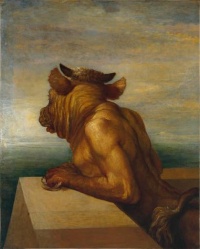Pasiphaë
From The Art and Popular Culture Encyclopedia

|
Related e |
|
Featured: |
In Greek mythology, Pasiphaë was the daughter of Helios and the sister of Circe. Married to King Minos of Crete, she is primarily known for having mated with a bull and giving birth to a minotaur, a creature half man half bull.
Contents |
Mother of a minotaur
Pasiphaë gave birth to the Minotaur, after a curse from Poseidon which caused her to mate with a white bull.
The curse by Poseidon caused Pasiphaë to be overcome with a fit of madness in which she fell in love with the bull. Pasiphae went to Daedalus for assistance, and Daedalus devised a way for her to satisfy her passions. He constructed a hollow wooden cow covered with cowhide for Pasiphae to hide in and allow the bull to mount her. The result of this union was the Minotaur.
Illustrations
- Pasiphae and the Bull (c.1876-80) by Moreau[1]
- Michael Parkes's one[2].
- Jean de Bosschere in Ars Amatoria[3]
- Johann Ulrich Krauss [4]
Oracular goddess
In mainland Greece, Pasiphaë was worshipped as an oracular goddess at Thalamae, one of the original koine of Sparta. The geographer Pausanias describes the shrine as small, situated near a clear stream, and flanked by bronze statues of Helios and Pasiphaë. His account also equates Pasiphaë with Ino and the lunar goddess Selene.
Cicero writes in De Natura Deorum that the Spartan ephors would sleep at the shrine of Pasiphaë, seeking prophetic dreams to aid them in governance. According to Plutarch, Spartan society twice underwent major upheavals sparked by ephors' dreams at the shrine during the Hellenistic era. In one case, an ephor dreamed that some of his colleagues' chairs were removed from the agora, and that a voice called out "this is better for Sparta"; inspired by this, King Cleomenes acted to consolidate royal power. Again during the reign of King Agis, several ephors brought the people into revolt with oracles from Pasiphaë's shrine promising remission of debts and redistribution of land.
Family
Like her doublet Europa, her origins were in the East, in her case at Colchis, she was given in marriage to King Minos of Crete. With Minos, she was the mother of Acacallis, Ariadne, Androgeus, Glaucus, Deucalion, Phaedra, Xenodice, and Catreus. She was also the mother of "starlike" Asterion, called by the Greeks the Minotaur, after a curse from Poseidon caused her to experience lust for and mate with a white bull sent by Poseidon. "The Bull was the old pre-Olympian Poseidon," Ruck and Staples remark.
In the Greek literalistic understanding of a Minoan myth, in order to actually copulate with the bull, she had the Athenian artificer Daedalus construct a portable wooden cow with a cowhide covering, within which she was able to satisfy her strong desire. Greek myth characteristically emphasizes the accursed unnaturalness of a mystical marriage conceived literally as merely carnal: a fragment of Bacchylides alludes to "her unspeakable sickness" and Hyginus (Fabulae 40) to "an unnatural love for a bull." The effect of the Greek interpretation was to reduce a more-than-human female, daughter of the Sun itself, to a stereotyped emblem of grotesque bestiality and the shocking excesses of female sensuality and deceit. Pasiphaë appeared in Virgil's Eclogue VI (45–60), in Silenus' list of suitable mythological subjects, on which Virgil lingers in such detail that he gives the sixteen-line episode the weight of a brief inset myth. In Ovid's Ars Amatoria Pasiphaë is reduced to unflattering human terms: Pasiphae fieri gaudebat adultera tauri—"Pasiphaë took pleasure in becoming an adulteress with a bull."
In other aspects, Pasiphaë, like her niece Medea, was a mistress of magical herbal arts in the Greek imagination. The author of Bibliotheke (3.197-198) records the fidelity charm she placed upon Minos, who would ejaculate serpents and scorpions, killing any unlawful concubine; but Procris, with a protective herb, lay with Minos with impunity.
See also

